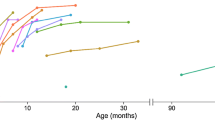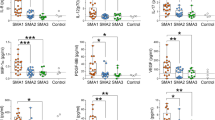Abstract
Objective
To determine the diagnostic and monitoring value of serum neurofilament light chain (NfL) in spinal muscular atrophy (SMA).
Methods
We measured serum NfL in 46 SMA patients at baseline and over 14 months of treatment with the antisense-oligonucleotide (ASO) nusinersen using the ultrasensitive single molecule array (Simoa) technology. Serum NfL levels of SMA patients were compared to controls and related to cerebrospinal fluid (CSF) NfL, blood-CSF barrier function quantified by the albumin blood/CSF ratio (Qalb) and motor scores (Hammersmith Functional Motor Scale Expanded, HFMSE; Amyotrophic Lateral Sclerosis Functional Rating Scale-Revised, ALSFRS-R).
Results
Serum NfL levels of SMA patients were in the range of controls (p = 0.316) and did not correlate with CSF NfL (ρ = 0.302, p = 0.142) or Qalb (ρ = − 0.160, p = 0.293). During therapy, serum NfL levels were relatively stable with notable concentration changes in single SMA patients, however, within the control range. Higher NfL levels were associated with worse motor performance in SMA (baseline: HFMSE ρ = − 0.330, p = 0.025, ALSFRS-R ρ = − 0.403, p = 0.005; after 10 months: HFMSE ρ = − 0.525, p = 0.008, ALSFRS-R ρ = − 0.537, p = 0.007), but changes in motor scores did not correlate with changes in serum NfL.
Conclusion
Diagnostic and monitoring performance of serum NfL measurement seems to differ between SMA subtypes. Unlike to SMA type 1, in adolescent and adult SMA type 2 and 3 patients, neurodegeneration is not reflected by increased NfL levels and short-term therapeutic effects cannot be observed. Long-term follow-up has to be performed to see if even low levels of NfL might be good prognostic markers.

Similar content being viewed by others
References
Lunn MR, Wang CH (2008) Spinal muscular atrophy. Lancet 371(9630):2120–33
De Sanctis R, Coratti G, Pasternak A, Montes J, Pane M, Mazzone ES et al (2016) Developmental milestones in type I spinal muscular atrophy. Neuromuscul Disord 26(11):754–759
Rudnik-Schöneborn S, Hausmanowa-Petrusewicz I, Borkowska J, Zerres K (2001) The predictive value of achieved motor milestones assessed in 441 patients with infantile spinal muscular atrophy types II and III. Eur Neurol 45(3):174–181
Ogino S, Wilson RB (2002) Genetic testing and risk assessment for spinal muscular atrophy (SMA). Hum Genet 111(6):477–500
Wurster CD, Ludolph AC (2018) Nusinersen for spinal muscular atrophy. Ther Adv Neurol Disord 11:1756285618754459
Mendell JR, Al-Zaidy S, Shell R, Arnold WD, Rodino-Klapac LR, Prior TW et al (2017) Single-dose gene-replacement therapy for spinal muscular atrophy. N Engl J Med 377(18):1713–1722
Yuan A, Rao MV, Veeranna KD, Nixon RA (2012) Neurofilaments at a glance. J Cell Sci 125(14):3257–3263
Hoffman PN, Cleveland DW, Griffin JW, Landes PW, Cowan NJ, Price DL (1987) Neurofilament gene expression: a major determinant of axonal caliber. Proc Natl Acad Sci USA 84(10):3472–3476
Kriz J, Zhu Q, Julien JP, Padjen AL (2000) Electrophysiological properties of axons in mice lacking neurofilament subunit genes: disparity between conduction velocity and axon diameter in absence of NF-H. Brain Res 885(1):32–44
Skillbäck T, Farahmand B, Bartlett JW, Rosén C, Mattsson N, Nägga K et al (2014) CSF neurofilament light differs in neurodegenerative diseases and predicts severity and survival. Neurology 83(21):1945–1953
Steinacker P, Feneberg E, Weishaupt J, Brettschneider J, Tumani H, Andersen PM et al (2016) Neurofilaments in the diagnosis of motoneuron diseases: A prospective study on 455 patients. J Neurol Neurosurg Psychiatry 87(1):12–20
Feneberg E, Oeckl P, Steinacker P, Verde F, Barro C, Van Damme P et al (2018) Multicenter evaluation of neurofilaments in early symptom onset amyotrophic lateral sclerosis. Neurology 90(1):e22–30
Verde F, Steinacker P, Weishaupt JH, Kassubek J, Oeckl P, Halbgebauer S et al (2019) Neurofilament light chain in serum for the diagnosis of amyotrophic lateral sclerosis. J Neurol Neurosurg Psychiatry 90(2):157–164
Winter B, Guenther R, Ludolph AC, Hermann A, Otto M, Wurster CD (2019) Neurofilaments and tau in CSF in an infant with SMA type 1 treated with nusinersen. J Neurol Neurosurg Psychiatry 90(9):1068–1069
Olsson B, Alberg L, Cullen NC, Michael E, Wahlgren L, Kroksmark A-K et al (2019) NFL is a marker of treatment response in children with SMA treated with nusinersen. J Neurol 266(9):2129–2136
Darras BT, Crawford TO, Finkel RS, Mercuri E, De Vivo DC, Oskoui M et al (2019) Neurofilament as a potential biomarker for spinal muscular atrophy. Ann Clin Transl Neurol 6(5):932–944
Wurster CD, Günther R, Steinacker P, Dreyhaupt J, Wollinsky K, Uzelac Z et al (2019) Neurochemical markers in CSF of adolescent and adult SMA patients undergoing nusinersen treatment. Ther Adv Neurol Disord 12:1756286419846058. https://doi.org/10.1177/1756286419846058
Brettschneider J, Petzold A, Süßmuth SD, Ludolph AC, Tumani H (2006) Axonal damage markers in cerebrospinal fluid are increased in ALS. Neurology 66(6):852–856
Menke RAL, Gray E, Lu CH, Kuhle J, Talbot K, Malaspina A et al (2015) CSF neurofilament light chain reflects corticospinal tract degeneration in ALS. Ann Clin Transl Neurol 2(7):748–755
Otto M, Bowser R, Turner M, Berry J, Brettschneider J, Connor J et al (2012) Roadmap and standard operating procedures for biobanking and discovery of neurochemical markers in ALS. Amyotroph Lateral Scler 13(1):1–10
Rissin DM, Kan CW, Campbell TG, Howes SC, Fournier DR, Song L et al (2010) Single-molecule enzyme-linked immunosorbent assay detects serum proteins at subfemtomolar concentrations. Nat Biotechnol 28(6):595–599
Wilson DH, Rissin DM, Kan CW, Fournier DR, Piech T, Campbell TG et al (2016) The Simoa HD-1 Analyzer: a novel fully automated digital immunoassay analyzer with single-molecule sensitivity and multiplexing. J Lab Autom 21(4):533–547
Jesse S, Brettschneider J, Süssmuth SD, Landwehrmeyer BG, Von Arnim CAF, Ludolph AC et al (2011) Summary of cerebrospinal fluid routine parameters in neurodegenerative diseases. J Neurol 258(6):1034–1041
O’Hagen JM, Glanzman AM, McDermott MP, Ryan PA, Flickinger J, Quigley J et al (2007) An expanded version of the Hammersmith Functional Motor Scale for SMA II and III patients. Neuromuscul Disord 17(9–10):693–697
Glanzman AM, O’Hagen J, McDermott M, Martens W, Flickinger J, Riley S et al (2011) Validation of the expanded Hammersmith Functional Motor Scale in spinal muscular atrophy type II and III. J Child Neurol 26(12):1499–1507
Cedarbaum JM, Stambler N, Malta E, Fuller C, Hilt D, Thurmond B et al (1999) The ALSFRS-R: a revised ALS functional rating scale that incorporates assessments of respiratory function: BDNF ALS study group (phase III). J Neurol Sci 169(1–2):13–21
Steinacker P, Huss A, Mayer B, Grehl T, Grosskreutz J, Borck G et al (2017) Diagnostic and prognostic significance of neurofilament light chain NF-L, but not progranulin and S100B, in the course of amyotrophic lateral sclerosis: data from the German MND-net. Amyotroph Lateral Scler Frontotemporal Degener 18(1–2):112–119
Lee S, Sunil N, Shea TB (2011) C-terminal neurofilament phosphorylation fosters neurofilament-neurofilament associations that compete with axonal transport. Cytoskeleton 68(1):8–17
Glanzman AM, Mazzone E, Main M, Pelliccioni M, Wood J, Swoboda KJ et al (2010) The Children’s Hospital of Philadelphia Infant Test of Neuromuscular Disorders (CHOP INTEND): test development and reliability The CHOP INTEND is a reliable measure of motor skills in patients with SMA-I and neuromuscular disorders presenting in infancy. Neuromuscul Disord 20(3):155–161
Oppenheim RW (1989) The neurotrophic theory and naturally occurring motoneuron death. Trends Neurosci 12(7):252–255
Pérez-García MJ, Kong L, Sumner CJ, Tizzano EF (2016) Developmental aspects and pathological findings in spinal muscular atrophy. In: Spinal muscular atrophy: disease mechanisms and therapy. Elsevier Inc. pp 21–42
Lombardi V, Querin G, Ziff OJ, Zampedri L, Martinelli I, Heller C et al (2019) Muscle and not neuronal biomarkers correlate with severity in spinal and bulbar muscular atrophy. Neurology 92(11):E1205–E1211
Poesen K, Van Damme P (2018) Diagnostic and prognostic performance of neurofilaments in ALS. Front Neurol 9:1167
Wadman RI, Wijngaarde CA, Stam M, Bartels B, Otto LAM, Lemmink HH et al (2018) Muscle strength and motor function throughout life in a cross-sectional cohort of 180 patients with spinal muscular atrophy types 1c–4. Eur J Neurol 25(3):512–518
Rudnik-Schoneborn S, Lutzenrath S, Borkowska J, Karwanska A, Hausmanowa-Petrusewicz I, Zerres K (1998) Analysis of creatine kinase activity in 504 patients with proximal spinal muscular atrophy types I–III from the point of view of progression and severity. Eur Neurol 39(3):154–162
Acknowledgements
The authors thank all patients for participating in this study. Thanks for technical assistance to Dagmar Schattauer, Sandra Hübsch, Alice Pabst and Mehtap Bulut-Karac.
Funding
The study was supported in part by grants from the German Federal Ministry of Education and Research [project FTLDc 01GI1007A, MND-Net 01GI0704]; PreFrontAls [01ED1512]; the ALS association; the Thierry Latran Foundation; and the Charcot Foundation for ALS Research. AH is supported by the Hermann und Lilly Schilling-Stiftung.
Author information
Authors and Affiliations
Consortia
Contributions
CDW design and conceptualized study. Major role in the acquisition of data. Analyzed the data. Wrote manuscript. PS design and conceptualized study. analyzed serum samples. Performed statistical analysis. Wrote manuscript. RG design and conceptualized study. Major role in the acquisition of data. Revised the manuscript for intellectual content. JCK major role in the acquisition of data. Revised the manuscript for intellectual content. PL Revised the manuscript for intellectual content. ZU major role in the acquisition of data. SW major role in the acquisition of data. KW major role in the acquisition of data. BW revised the manuscript for intellectual content. AO major role in the acquisition of data. OS-K major role in the acquisition of data. RAS analyzed serum samples. ACL design and conceptualized study. Interpreted the data. Revised the manuscript for intellectual content. SP major role in the acquisition of data. Revised the manuscript for intellectual content. AH design and conceptualized study. Revised the manuscript for intellectual content. MO design and conceptualized study. Analyzed and interpreted the data. Revised the manuscript for intellectual content.
Corresponding author
Ethics declarations
Conflicts of interest
The authors declared the following potential conflicts of interest with respect to the research, authorship, and/or publication of this article: CDW has received honoraria from Biogen as an Advisory board member and for lectures and as a consultant from Hoffmann-La Roche. She also received travel expenses from Biogen. PS, SW, KW and MRAS report no disclosures. RG has received honoraria from Biogen as an Advisory board member. JCK has received financial research support form TEVA Pharmaceuticals and honoraria as speaker/consultant for AbbVie, Allergan, Biogen, Ipsen and AveXis/Novartis. PL has received financial research support from TEVA Pharmaceuticals and honoraria as speaker/consultant for AbbVie, Atheneum Partners, BIAL, Desitin, Licher MT, Medtronic, Novartis. ZU has received honoraria from Biogen as a consultant. BW has received honoraria from Biogen for a lecture. AO has received honoraria from Biogen as a consultant. OSK has received honoraria as a speaker/consultant and/or funding for travel expenses from the Deutsche Gesellschaft für Muskelkranke (DGM e.V.), Novartis, Biogen GmbH, the Jain Foundation. She received academic research support by Ludwig-Maximilians-University of Munich, FoeFoLe program, Reg.-No. 747, 11/11–05/13, and MHH Young Faculty Program, 2018–2020 as well as research support by foundations and societies by the Friedrich-Baur-GmbH, Burgkunstadt 12/13–12/15 and the Deutsche Gesellschaft für Muskelkranke (DGM e.V.), 2019–20. ACL received financial research support from AB Science, Biogen Idec, Cytokinetics, GSK, Orion Pharma, Novartis, TauRx Therapeutics Ltd. and TEVA Pharmaceuticals. He also has received honoraria as a consultant from Mitsubishi, Orion Pharma, Novartis, Teva and as an Advisory board member of Biogen and Hoffmann-La Roche. SP has received honoraria as speaker/consultant from Biogen Idec, Novartis, Cytokinetics, TEVA Pharmaceuticals, Desitin. AH has received honoraria from Biogen and Desitin as a consultant. MO received honoraria as consultant from Biogen, Axon and Fujirebio.
Ethical standards
The study was approved by the local ethics committees of the centers involved in Ulm, Dresden, Göttingen and Hannover (approval number at central study center at Ulm University 19/12; 2012) and all patients or their relatives (legal guardian) gave informed written consent to participate in the study.
Rights and permissions
About this article
Cite this article
Wurster, C.D., Steinacker, P., Günther, R. et al. Neurofilament light chain in serum of adolescent and adult SMA patients under treatment with nusinersen. J Neurol 267, 36–44 (2020). https://doi.org/10.1007/s00415-019-09547-y
Received:
Revised:
Accepted:
Published:
Issue Date:
DOI: https://doi.org/10.1007/s00415-019-09547-y




